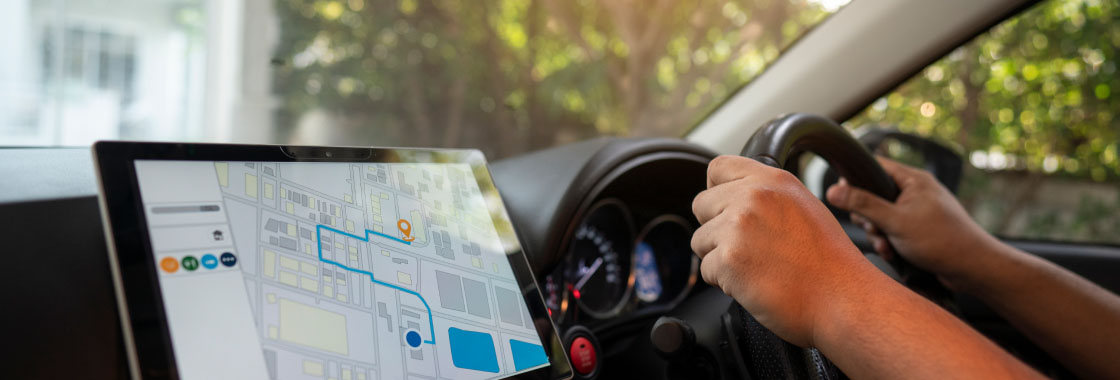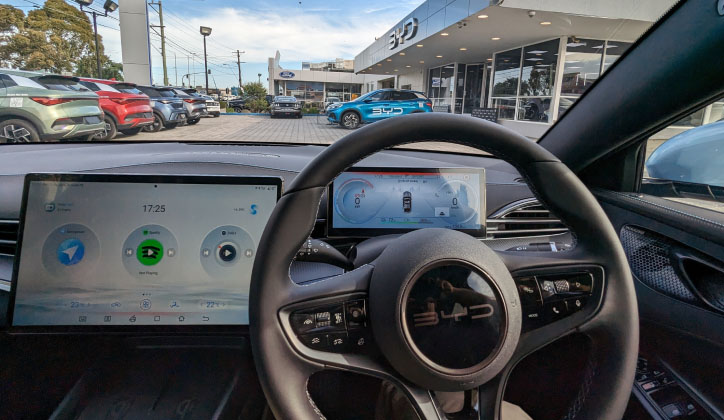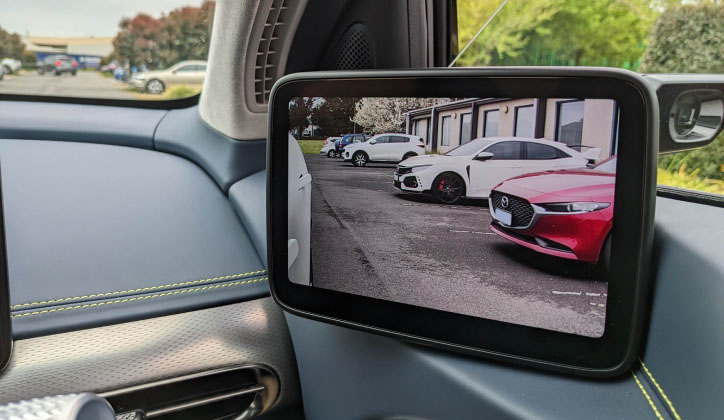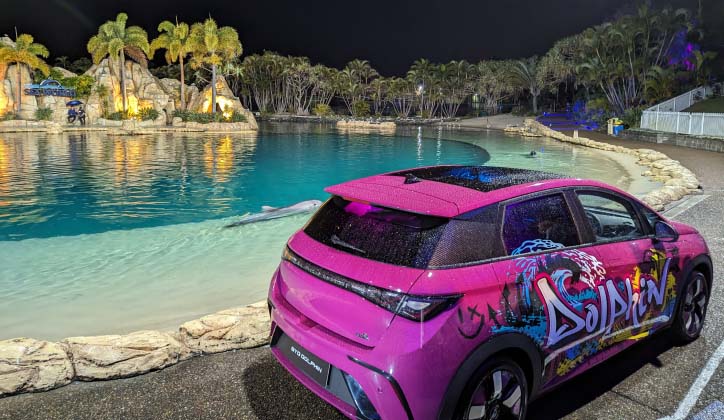We discuss the following main features in this article:
- Infotainment screens
- Safety cameras
- Passenger safety
- Digital mirrors
- Over the air updates
- Sentry Mode
- Advanced driver-assistance systems

We discuss the following main features in this article:
Screens in EVs are getting bigger, reflecting a general shift towards increased digital experience and connectivity in cars.
This shift is driven by a few factors including cost savings in large-screen technologies, and drivers wanting a more interactive and feature-rich infotainment system. Infotainment screens have become the central hub for vehicle functions, including navigation, media playback, climate control, and more.

These large displays make it easier for drivers and passengers to control things in their car without pressing multiple physical buttons. Having less buttons and dials in the interior of EVs helps improve safety by increasing driver attention on the road. The large screens also help to improve the visibility of these controls.
A pioneer of large screens in cars has been Tesla, which is famous for using one screen in its popular Model 3 and Model Y vehicles.
Other newer brands like BYD are offering similar experiences with larger screens and this trend in EVs is likely to continue.
The number of cameras in cars has increased significantly in recent years. Tesla famously has up to 8 cameras in some of its models to help the car display its surroundings. This helps make the car a lot safer, as drivers can identify obstructions and pedestrians more easily.
Many EVs have camera systems that make it easier for the vehicles to display all around them, giving the driver a Birdseye view. These cameras can help make it easier to park in tighter car park spots and reduce low-speed accidents.

Sensors and Advanced Driver-Assistance Systems (ADAS) can collect information about the car’s surroundings and combine it with the camera data to help prevent accidents at different speeds.
This also helps other road users, like pedestrians and cyclists, where the car’s cameras can at times perceive them before the driver can, making the roads safer for everyone.
Modern EVs have a lot of safety packed into them. This includes features to make it safer for passengers and occupants of the car.
EVs like Tesla vehicles have additional safety features, which can keep the air-conditioning on to keep the car’s cabin within a safe temperature.
The car is able to detect infants and pets using Tesla’s cabin camera. The cabin camera can also detect driver inattentiveness and remind you to keep your eyes on the road when Autopilot’s on.
Tesla vehicles also have climate control features including cabin overheat protection, which stops the car’s cabin from getting too hot.
Similar features for pets are also built into the car. Features like Dog Mode can maintain the car’s temperature for pets while they wait for the driver to return to the car. The screen of the car also displays information such as the current cabin temperature and a message for passersby, letting them know that the pet is safe inside the car with its windows up.
Other EVs also have cabin detection systems to sense if an infant or child is left in the back seat.
Some upcoming EVs from Volvo take this a step further by using radars on the inside of the car to detect pets and infants, before allowing the car to be locked. When a driver attempts to lock the car, the radar system is activated and will send alerts if it detects movement inside the car.
Speaking of cameras, some EVs are even removing side mirrors and replacing them with cameras and screens.
The screens on the inside can show real-time video feed from these digital mirrors. These can help with improving visibility, as the cameras can have a wider view than a conventional mirror.
When it comes to safety, digital mirrors can help with judging distances between cars when changing lanes.
Some vehicles augment lines when an indicator is turned on, so the driver can judge the distance between their car and those in the lane they’re moving into. This makes changing lanes on highways safer.

Some EVs that have digital side mirrors include:
Over-the-air (OTA) updates are like receiving a software upgrade on your smartphone, but for your EV. They’re a convenient way to keep your EV up to date and ensure it's running at its best.
Car manufacturers send these updates wirelessly to your EV to improve its functionality, enhance performance, add new features including those that help make the car safer, or fix bugs, without the need for you to visit a dealership or service centre.
Tesla, a pioneer in the use of OTA updates, has been using this technology to improve its vehicles' software, performance, and even driving range since the early days of the Model S.
Often in the media, vehicles may be “recalled”, but an over-the-air update takes place to fix a potential problem.
Sentry Mode is a security feature available in Tesla EVs, designed to monitor the surroundings of the car when it's parked and you’re away.
This innovative system uses the vehicle's built-in cameras to keep an eye on the environment, essentially turning the car into a vigilant security guard.
When activated, Sentry Mode uses the Tesla’s cameras to monitor for potential threats.
If Sentry Mode perceives a more significant threat, it goes into an “Alarm” state. This triggers the car alarm, increases the brightness of the central display, and plays loud music to attract attention, all while recording footage of the incident.
The recorded footage is saved to a USB drive that you must install in the car. You can now see Sentry Mode footage live from your Tesla app.
Most EVs are equipped with Advanced driver-assistance systems (ADAS), which include automatic emergency braking, lane-keeping assistance, and adaptive cruise control, among others.
ADAS can help reduce the impact of collisions in EVs. In some instances, they can help avoid a collision all together, thanks to various sensors and software that monitor the road.
The automatic emergency braking system helps by applying brakes on a car if the car is likely to get into a collision with other vehicles on the road.
Some systems even go as far as looking out for pedestrians and other vulnerable road users like cyclists. This makes the road safer for other road users.
Lane-keeping assist is another feature as part of the ADAS in most newer cars, including EVs. It prevents the car from veering into another lane or barriers on the side of the road.
It’s worth keeping in mind that some lane-keep assist systems only activate once the car has reached a particular speed.
These systems aren’t perfect, with some cars having issues such as driving systems directing vehicles out of their lanes. So it’s important to stay alert.
In Australia, the advancement of technology in EVs has significantly enhanced their safety, making modern cars safer than ever.
This progress is reflected in the Australian New Car Assessment Program (ANCAP) ratings, where a 5-star rating represents the highest level of safety a vehicle can achieve.
Models such as the Tesla Model Y, BYD Seal, and the BYD Dolphin exemplify this trend, incorporating cutting-edge safety features and technologies that contribute to their 5-star ANCAP ratings.
These vehicles are equipped with ADAS.

Having advanced safety technologies and achieving high ANCAP ratings in vehicles like the Tesla Model Y and BYD Seal highlights the car industry's commitment to enhancing vehicle safety.
This trend towards safer vehicles, supported by technological advancements, is a positive development for all road users in Australia.
If you are considering making the switch to an electric vehicle, check out the Allianz EV Hub for info and resources to help give you a head start on your EV journey.
This article has been prepared by Allianz Australia Insurance Limited ABN 15 000 122 850 AFSL234708 ("Allianz"). In some cases, information has been provided to us by third parties and while that information is believed to be accurate and reliable, its accuracy is not guaranteed in any way.
Any opinions expressed constitute our views at the time of issue and are subject to change. Neither Allianz, nor its employees or directors give any warranty of accuracy or accept responsibility for any loss or liability incurred by you in respect of any error, omission or misrepresentation in this article.
Any advice here does not take into account your individual objectives, financial situation or needs. Terms, conditions, limits, and exclusions apply. Before making a decision about this insurance, consider the relevant Product Disclosure Statement (PDS)/Policy Wording and Supplementary PDS (if applicable). Where applicable, the PDS/Policy Wording, Supplementary PDS and Target Market Determination (TMD) for this insurance are available on this website. We do not provide any form of advice if you call us to enquire about or purchase a product.
Allianz Australia Insurance Limited ABN 15 000 122 850 AFS Licence No. 234708 is the insurer of any general insurance products offered, and Allianz Australia Life Insurance Limited ABN 27 076 033 782 AFS Licence No. 296559 is the insurer of any life insurance products offered. Each entity is responsible for any statements and representations made about its products, on this website.